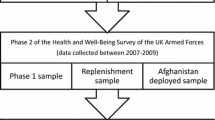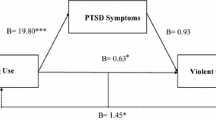Abstract
The current study screened for post-traumatic stress disorder (PTSD) and self-harming behaviours, often related to borderline personality disorder (BPD), among individuals in a job centre considered unemployable primarily for psychological reasons. Participants (N = 112) filled in questionnaires on PTSD symptoms (n = 62) and self-harming behaviours (n = 59) as part of participating in team-meetings providing the individuals with a return-to-work plan. Differences in demographic variables between individuals with and without valid protocols were small to moderate. Of the individuals filling in the PTSD questionnaire 40% fulfilled criteria for probable PTSD and 31% of the individuals filling in the questionnaire on self-harming behaviours reported five or more types of self-harming behaviours. Only a minority of these individuals had PTSD or BPD respectively mentioned in their case records. Further investigation of the prevalence of PTSD and self-harming behaviour among individuals considered unemployable is warranted as well as an enhanced focus in jobcentres and other institutions supporting employability on detection and treatment of PTSD and early signs of BPD.
Similar content being viewed by others
References
Arens, E. A., Stopsack, M., Spitzer, C., Appel, K., Dudeck, M., Volzke, H., et al. (2013). Borderline personality disorder in four different age groups: A cross-sectional study of community residents in Germany. Journal of Personality Disorders, 27, 196–207.
Audhoe, S. S., Hoving, J. L., Nieuwenhuijsen, K., Friperson, R., de Jong, P. R., Sluiter, J. K., et al. (2012). Prognostic factors for the work participation of sick-listed unemployed and temporary agency workers with psychological problems. Journal of Occupational Rehabilitation, 22, 437–446.
Biskin, R. S., & Paris, J. (2012). Diagnosing borderline personality disorder. Canadian Medical Association Journal, 184, 1789–1794.
Bobo, W. V., Warner, C. H., & Warner, C. M. (2007). The management of post traumatic stress disorder (PTSD) in the primary care setting. Southern Medical Journal, 100, 797–802.
Bohus, M., & Kroger, C. (2011). Psychopathology and psychotherapy of borderline personality disorder: State of the art. Der Nervenarzt, 82, 16–24.
Brewin, C. R., Andrews, B., & Valentine, J. D. (2000). Meta-analysis of risk factors for posttraumatic stress disorder in trauma-exposed adults. Journal of Consulting and Clinical Psychology, 68, 748–766.
Bunting, B. P., Murphy, S. D., O’Neill, S. M., & Ferry, F. R. (2012). Lifetime prevalence of mental health disorders and delay in treatment following initial onset: evidence from the Northern Ireland Study of Health and Stress. Psychological Medicine, 42, 1727–1739.
Comtois, K. A., Kerbrat, A. H., Atkins, D. C., Harned, M. S., & Elwood, L. (2010). Recovery from disability for individuals with borderline personality disorder: a feasibility trial of DBT-ACES. Psychiatric Services, 61, 1106–1111.
Crespo, M., & Gomez, M. M. (2016). Diagnostic concordance of DSM-IV and DSM-5 posttraumatic stress disorder (PTSD) in a clinical sample. Psicothema, 28, 161–166.
Cusack, K. J., Grubaugh, A. L., Knapp, R. G., & Frueh, B. C. (2006). Unrecognized trauma and PTSD among public mental health consumers with chronic and severe mental illness. Community Mental Health Journal, 42, 487–500.
Darves-Bornoz, J. M., de Alonso, J., de Girolamo G., Graaf R., Haro, J. M., Kovess-Masfety, V., et al. (2008). Main traumatic events in Europe: PTSD in the European study of the epidemiology of mental disorders survey. Journal of Traumatic Stress, 21, 455–462.
Dorrington, S., Zavos, H., Ball, H., McGuffin, P., Rijsdijk, F., Siribaddana, S., et al. (2014). Trauma, post-traumatic stress disorder and psychiatric disorders in a middle-income setting: Prevalence and comorbidity. The British Journal of Psychiatry, 205, 383–389.
Elklit, A., Norregaard, J., & Tibor, B. (1998). Occurrence and type of traumatic experiences among young Bosnian refugees in Denmark. Ugeskr. Laeger, 160, 4310–4314.
Ferry, F. R., Brady, S. E., Bunting, B. P., Murphy, S. D., Bolton, D., & O’Neill, S. M. (2015). The Economic Burden of PTSD in Northern Ireland. Journal of Traumatic Stress, 28, 191–197.
Frommberger, U., Angenendt, J., & Berger, M. (2014). Post-traumatic stress disorder: A diagnostic and therapeutic challenge. Dtsch. Arztebl. Int, 111, 59–65.
Hansen, M., Andersen, T. E., Armour, C., Elklit, A., Palic, S., & Mackrill, T. (2010). PTSD-8: A short PTSD inventory. Clinical Practice and Epidemiology in Mental Health, 6, 101–108.
Haravuori, H., Kiviruusu, O., Suomalainen, L., & Marttunen, M. (2016). An evaluation of ICD-11 posttraumatic stress disorder criteria in two samples of adolescents and young adults exposed to mass shootings: Factor analysis and comparisons to ICD-10 and DSM-IV. BMC Psychiatry, 16, 140. https://doi.org/10.1186/s12888-016-0849-y.
Hoge, C. W., Riviere, L. A., Wilk, J. E., Herrell, R. K., & Weathers, F. W. (2014). The prevalence of post-traumatic stress disorder (PTSD) in US combat soldiers: a head-to-head comparison of DSM-5 versus DSM-IV-TR symptom criteria with the PTSD checklist. Lancet Psychiatry, 1, 269–277.
Kessler, R. C. (2000). Posttraumatic stress disorder: The burden to the individual and to society. Journal of Clinical Psychiatry, 61(Suppl 5), 4–12 (discussion 13–4).
Kiely, K. M., & Butterworth, P. (2014). Mental health selection and income support dynamics: Multiple spell discrete-time survival analyses of welfare receipt. Journal of Epidemiol Community Health, 68, 349–355.
Kimerling, R., Alvarez, J., Pavao, J., Mack, K. P., Smith, M. W., & Baumrind, N. (2009). Unemployment among women: Examining the relationship of physical and psychological intimate partner violence and posttraumatic stress disorder. Journal of Interpersonal Violence, 24, 450–463.
Lang, U. E., & Hellweg, R. (2006). Prevalence and role of psychiatric disorders in disability. Versicherungsmedizin/herausgegeben von Verband der Lebensversicherungs-Unternehmen e. V. und Verband der Privaten Krankenversicherung e.V, 58, 164–169.
Le, Q. A., Doctor, J. N., Zoellner, L. A., & Feeny, N. C. (2014). Cost-effectiveness of prolonged exposure therapy versus pharmacotherapy and treatment choice in posttraumatic stress disorder (the optimizing PTSD treatment trial): A doubly randomized preference trial. Journal of Clinical Psychiatry, 75, 222–230.
Liebschutz, J., Saitz, R., Brower, V., Keane, T. M., Lloyd-Travaglini, C., Averbuch, T., et al. (2007). PTSD in urban primary care: High prevalence and low physician recognition. Journal of General Internal Medicine, 22, 719–726.
Maercker, A., Forstmeier, S., Wagner, B., Glaesmer, H., & Brahler, E. (2008). Post-traumatic stress disorder in Germany. Results of a nationwide epidemiological study. Der Nervenarzt, 79, 577–586.
Matthews, L. R., Harris, L. M., Jaworski, A., Alam, A., & Bozdag, G. (2013). Function in job seekers with mental illness and drug and alcohol problems who access community based disability employment services. Disability and Rehabilitation, 35, 460–467.
Nandi, A., Galea, S., Tracy, M., Ahern, J., Resnick, H., Gershon, R., et al. (2004). Job loss, unemployment, work stress, job satisfaction, and the persistence of posttraumatic stress disorder one year after the September 11 attacks. Journal of Occupational and Environmental Medicine, 46, 1057–1064.
Newcombe, R. G. (1998). Interval estimation for the difference between independent proportions: comparison of eleven methods. Statistics in Medicine, 17, 873–890.
Newcombe, R. G. (1999). The value of the negative predictive values. British Journal of Obstetrics and Gynaecology, 106, 1331–1332.
Newcombe, R. G. (2002). generalisedmw1.xls [MS excel-file]. Retrieved May 25, 2010, from http://medicine.cf.ac.uk/en/research/research-groups/clinical-epidemiology/resources/ [Computer software]. Cardiff University, School of Medicine.
Newcombe, R. G. (2006). Confidence intervals for an effect size measure based on the Mann–Whitney statistic. Part 1: General issues and tail-area-based methods. Statistics in Medicine, 25, 543–557.
Perkonigg, A., Kessler, R. C., Storz, S., & Wittchen, H.-U. (2000). Traumatic events and post-traumatic stress disorder in the community: Prevalence, risk factors and comorbidity. Acta Psychiatrica Scandinavica, 101, 46–59.
Peters, L., Slade, T., & Andrews, G. (1999). A comparison of ICD10 and DSM-IV criteria for posttraumatic stress disorder. Journal of Traumatic Stress, 12, 335–343.
Powers, M. B., Halpern, J. M., Ferenschak, M. P., Gillihan, S. J., & Foa, E. B. (2010). A meta-analytic review of prolonged exposure for posttraumatic stress disorder. Clinical Psychology Review, 30, 635–641.
Rosenthal, R., & Rubin, D. B. (2003). r equivalent: A simple effect size indicator. Psychological methods, 8, 492–496.
Sansone, R. A., & Sansone, L. A. (2010). Personality dysfunction and employment dysfunction: double, double, toil and trouble. Psychiatry, 7, 12–16.
Sansone, R. A., & Sansone, L. A. (2012). Employment in borderline personality disorder. Innovations in Clinical Neuroscience, 9, 25–29.
Sansone, R. A., Wiederman, M. W., & Sansone, L. A. (1998). The Self-Harm Inventory (SHI): Development of a scale for identifying self-destructive behaviors and borderline personality disorder. Journal of Clinical Psychology, 54, 973–983.
Smith, M. W., Schnurr, P. P., & Rosenheck, R. A. (2005). Employment outcomes and PTSD symptom severity. Mental Health Services Research, 7, 89–101.
Soegaard, H. J. (2012). Undetected common mental disorders in long-term sickness absence. International Journal of Family Medicine. https://doi.org/10.1155/2012/474989.
Sogaard, H. J., & Bech, P. (2009). Psychiatric disorders in long-term sickness absence: A population-based cross-sectional study. Scandinavian Journal of Public Health, 37, 682–689.
Stoffers, J. M., Vollm, B. A., Rucker, G., Timmer, A., Huband, N., & Lieb, K. (2012). Psychological therapies for people with borderline personality disorder. Cochrane Database System Review. https://doi.org/10.1002/14651858.CD005652.pub2.
Svedberg, P., Salmi, P., Hagberg, J., Lundh, G., Linder, J., & Alexanderson, K. (2010). Does multidisciplinary assessment of long-term sickness absentees result in modification of sick-listing diagnoses? Scandinavian Journal of Public Health, 38, 657–663.
Taubman-Ben-Ari, O., Rabinowitz, J., Feldman, D., & Vaturi, R. (2001). Post-traumatic stress disorder in primary-care settings: Prevalence and physicians’ detection. Psychological Medicine, 31, 555–560.
van Rijn, R. M., Robroek, S. J., Brouwer, S., & Burdorf, A. (2014). Influence of poor health on exit from paid employment: A systematic review. Occupational and Environmental Medicine, 71, 295–301.
Wagner, T., Fydrich, T., Stiglmayr, C., Marschall, P., Salize, H. J., Renneberg, B., et al. (2014). Societal cost-of-illness in patients with borderline personality disorder one year before, during and after dialectical behavior therapy in routine outpatient care. Behaviour Research and Therapy. 61, 12–22. https://doi.org/10.1016/j.brat.2014.07.004.
Weaver, B., & Koopman, R. (2014). An SPSS macro to compute confidence intervals for Pearson’s correlation. Quantitative Methods for Psychology, 10, 29–39.
Zanarini, M. C., Frankenburg, F. R., Reich, D. B., & Fitzmaurice, G. (2010). The 10-year course of psychosocial functioning among patients with borderline personality disorder and axis II comparison subjects. Acta Psychiatrica Scandinavica, 122, 103–109.
Zanarini, M. C., Horwood, J., Wolke, D., Waylen, A., Fitzmaurice, G., & Grant, B. F. (2011). Prevalence of DSM-IV borderline personality disorder in two community samples: 6330 English 11-year-olds and 34,653 American adults. Journal of Personality Disorders, 25, 607–619.
Zanarini, M. C., Jacoby, R. J., Frankenburg, F. R., Reich, D. B., & Fitzmaurice, G. (2009). The 10-year course of social security disability income reported by patients with borderline personality disorder and axis II comparison subjects. Journal of Personality Disorders, 23, 346–356.
Zanarini, M. C., Vujanovic, A. A., Parachini, E. A., Boulanger, J. L., Frankenburg, F. R., & Hennen, J. (2003). A screening measure for BPD: The McLean screening instrument for borderline personality disorder (MSI-BPD). Journal of Personality Disorders, 17, 568–573.
Zimmerman, M., Martinez, J. H., Young, D., Chelminski, I., & Dalrymple, K. (2012). Sustained unemployment in psychiatric outpatients with bipolar depression compared to major depressive disorder with comorbid borderline personality disorder. Bipolar Disorders, 14, 856–862.
Acknowledgements
We are grateful to the participating individuals for taking the time and effort to answer the questionnaires. We thank Rune Andersen for providing the Danish version of the Self-Harming Inventory and Peter Elsner for corrections to the manuscript.
Author information
Authors and Affiliations
Corresponding author
Rights and permissions
About this article
Cite this article
Hansen, J.S., Simonsen, E. Probable Post-traumatic Stress Disorder and Self-harming Behaviour: Potential Barriers to Employment?. Community Ment Health J 54, 823–830 (2018). https://doi.org/10.1007/s10597-017-0180-1
Received:
Accepted:
Published:
Issue Date:
DOI: https://doi.org/10.1007/s10597-017-0180-1




